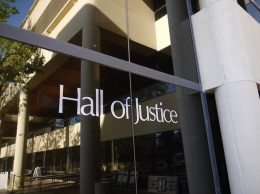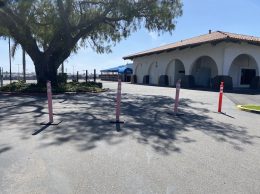
Firefighters watch the flames as the Thomas fire approaches homes in Montecito on Dec. 12.
Updated on Dec. 29:
Losses mounted for tri-county agriculture as firefighters gained ground on the Thomas fire over the Christmas holiday weekend.
Containment jumped to 88 percent as of press time on Dec. 26, with 281,620 acres reported burned — officially the largest fire in the state’s history.
Nearly 900 fire personnel remained on hand throughout the weekend, building on previously established fire lines for a blaze that is now estimated to have cost upward of $177 million to contain.
Some growers whose properties were impacted by the fire began to measure their losses.
The Rancho Ventura Conservation Trust suffered an estimated $1 million in damages, said co-founder Richard Atmore of RA Atmore & Sons. In addition to 6,000 acres of oak woodlands, Atmore said 91 acres of avocados, dozens of cattle, tractors, barns and feed were all destroyed in the blaze.
With 28 employees relying on the ranch for work, Atmore was already looking toward recovery and restoration. But the many avocado growers who lost crops will find replanting a difficult prospect in an already tight market for new trees.
Nurseries that were struggling to keep up with demand for avocado trees before the fire are now sold out through 2020, sources said. Brokaw Nursery in Ventura, which with 300,000 plants produced per year is one of the nation’s largest avocado tree providers, reported that it had not been damaged and that trees grown for delivery in 2018 were unharmed by heat and winds that drove would-be crops to the ground throughout the region.
But it takes two to three years to get a crop from a new tree, so even those who are able to find replacements will be nearing the limits of what their crop insurance can cover, said Jason Cole, a Santa Paula grower who has served on the Farm Bureau of Ventura County and the California Avocado Commission.
“There are these programs and there’s money available, but the one thing nobody can get is avocado trees,” Cole said. Imports have a quarantine period of two years, and going from seed to viable tree takes 18 months and increases labor costs, “so it’s irrelevant. You’re out two years no matter which way you go. It’s a conundrum. It’s the kind of thing you don’t plan for.”
Very near the epicenter of the wildfire, Cole compared the 200 acres of avocado trees he lost to a scene from Netflix hit “Stranger Things” — colored in black and grey, with ash and dust floating on each gust of wind.
“You see all these dead trees and it’s depressing. You almost don’t want to be out there,” Cole said. “It was this thriving, food-giving piece of earth, and now it just looks dead.”
Some of the property’s hoses and irrigation systems also melted, and others were idle during a 16-day blackout in the area. Cole estimated that he lost 3 million pounds of fruit, but with no homes burned, said he was trying to remain positive and see the extra carbon from the ash as good for the soil.
Some trees that look dead now may rebound, he said, and some that look healthy might not. While a U.S. Department of Agriculture program through the Natural Resource Conservation Service will help with clearing the land, new plantings can’t go into the ground until after the frost, so Cole said most farmers will leave old stumps in the ground to help prevent erosion and mudslides if the region receives heavy rains.
While it’s not usually at this scale, fire is something growers are used to dealing with, said Ben Faber, an adviser for the UC Cooperative Extension Ventura County. However, where they used to plant around 100 trees per acre, that number may double as growers look for more returns.
Santa Ana winds are “just part of farming in Ventura County,” Cole said, but the recent winds that pushed the Thomas fire required a whole new code above red, destroying in a week a quarter of his ranch that took his grandfather 50 years to build.
“Magenta winds and the largest fire in history — it’s been a pretty brutal month,” he said. “We’re just trying to make the best of a very unfortunate situation. Farmers are tough, so they’ll bounce back.”
Updated on Dec. 22:
As the Thomas fire heads toward the history books and recovery efforts get under way, Ventura County residents filed a lawsuit laying blame for the blaze at the feet of Southern California Edison, the city of Ventura and the Casitas Municipal Water District.
At press time on Dec. 20, the Thomas fire had grown to 272,000 acres and firefighters had been able to take advantage of light winds and relatively high humidity to achieve 60 percent containment. Costs to fight the fire had reached nearly $157 million, with 770 single family homes destroyed and another 207 damaged.
Firefighters were hoping that wind events in the forecast would not wreak the kind of havoc that has plagued efforts to contain a fire that nearly engulfed the city of Ventura on Dec. 5.
In a lawsuit filed in Ventura County Superior Court, plaintiffs allege that SCE employees and contractors were conducting construction activities near a campground and Comcast satellite facility in Santa Paula where the fire is thought to have started in the evening hours of Dec. 4. Additionally, the suit claims, some of the utility’s infrastructure was aging or not properly maintained.
Firefighters who responded to the incident also found themselves without water when the city lost power and backup generators failed to supply enough water pressure to fire hydrants, according to the suit, which was filed Dec. 15.
The city and the water district both declined to comment on the lawsuit, saying that they had not yet been served with paperwork.
Though he had not yet seen the suit, Casitas Public Affairs Manager Ron Merckling said that all of the district’s hydrants were operational and there was no decline in water pressure during the fires. Operating using a gravity-fed system, only one tank went dry in the Ojai area, and then only after the fire had passed through.
Brandon Vaccaro, an information officer for the Thomas fire, said that it’s not unusual to run short on water in rural areas when fighting fires, but that the cause of the fire may not be known for some time. Investigations begin immediately but have to narrow down the area where calls originally came in and people reported seeing fires pop up.
“Especially with a fire that’s almost 300,000 acres, we have to weed through all that, because many people saw a fire start,” Vaccaro said. Most reports are likely spot fires from floating embers. “It’ll probably take a while.”
While SCE originally stated that it was unlikely any of its equipment was involved in the fire, the company said in a news release Dec. 11 that portions of its infrastructure were now part of the Cal Fire investigation. SCE representatives did not respond to requests for comment on the lawsuit by press time.
Thomas Aquinas College — which was very near where the fire broke out, giving it its name — said recovery costs continue to mount, including additional campus security during the shutdown, the loss of spoiled food from the power outages, tree and brush removal, and the expense of rescheduling final exams for early January.
RECOVERY EFFORTS
In Ventura County, Supervisor Steve Bennett invited a family of evacuees into his home, urging others to do the same through Homeshare of Ventura.
Small businesses throughout the region also found creative ways to raise funds or support residents and emergency responders.
Ventura Coast Brewing Co. hosted an event with a silent auction, raising $30,000 in partnership with several food vendors citywide.
After fires temporarily shut down its offices and displaced its staff members in Northern California and the Tri-Counties, Rabobank pitched in $50,000 for recovery assistance for each incident.
Help even flowed in from Los Angeles, where CBS2 and KCAL9 raised more than $400,000 for Red Cross relief efforts, including $250,000 from the LA Chargers.
“As far as the business, it has truly been a week like no other,” said Johanna Zlenko, owner of The Closet Trading Co. in Santa Barbara. “Even during the Zaca fire back in 2007 I don’t remember anything like this.”
Zlenko said she considered canceling the company’s holiday party, but instead decided to make it a benefit for fire victims. The company donated proceeds from the event and offered a discount to customers who brought in toiletries for donation.
Other retailers in Santa Barbara offered discounts or merchandise to Thomas fire victims, passed out masks or collected donated clothing. Several offered to donate a portion of their sales.
In San Luis Obispo, the owner of the Sands Inn and Suites got behind the bar while hosting a reception for evacuees who had fled north to escape the fire and smoke. The hotel was among many to offer discounted rates for fire victims.
“Whether it’s simply to provide a space for our customers to feel some normalcy amidst the chaos or to provide supplies and support to those affected by the fire, our priority at this point is less about meeting holiday sales targets and more about helping our community feel loved, safe and supported which is truly what this holiday season is about,” Zlenko said.
Facing steep declines in sales during what is usually their peak season, many retailers were anxious to let customers know they were still open.
“Saturday was a bad day,” said Kate Schwab, marketing and communications director for Downtown Santa Barbara. “We’re not even going to sugarcoat it.”
A heavy blanket of smoke and evacuation warnings as the fire edged its way into the city of Santa Barbara forced many businesses to close.
Sherry Villanueva, owner of Santa Barbara-based Acme Hospitality, which includes The Lark, Lucky Penny, Loquita and other food and beverage businesses, estimated that sales were about 5 percent of normal.
But by Monday, crews were sweeping ash off cobblestones and windowsills, Schwab said, and the organization’s web page was flooded with businesses advertising holiday specials and fire support.
Now, they’re eager to welcome back customers.
“If ever there was a year that we need the whole community to be supporting local businesses, it’s now,” Villanueva said. “Small businesses tend to operate somewhat on the edge, and a disaster like this can really have long-term, devastating effects.”






 Print
Print Email
Email
















